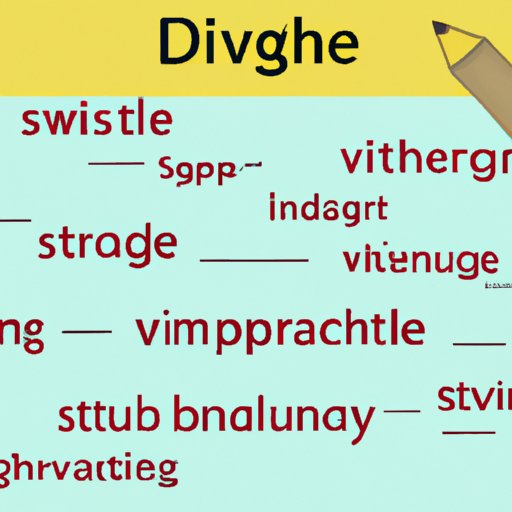Introduction
Good descriptive writing is the ability to paint a vivid picture for your reader using words. It involves creating a mental image of what is being described using language that engages the five senses. Through the use of descriptive writing, writers are able to provide detailed descriptions of people, places, objects, and events that come alive for their readers.
In this article, we’ll explore the different techniques that can be used to become a more descriptive writer. We’ll look at the importance of sensory language, metaphors and similes, character description, strong verbs, dialogue, adjectives, adverbs, and storytelling. By the end, you’ll have a better understanding of how to use these tools to make your writing more vibrant and engaging.
Using Sensory Language
Sensory language engages the five senses—sight, sound, smell, taste, and touch—to create a more vivid image in the reader’s mind. This type of language helps to bring the scene to life and make it more real for the reader. For example, instead of simply saying “The room was dark,” you could say “The room was as black as night, with only the faint light of the moon filtering through the window.”
By adding sensory language to your descriptions, you’re able to engage the reader on a deeper level and help them to visualize what’s happening. You can also use sensory language to evoke emotions in the reader by describing smells, tastes, and textures that are associated with certain feelings.
Metaphors and Similes
Metaphors and similes are two of the most powerful tools in a descriptive writer’s arsenal. They allow you to compare two seemingly unrelated things to illustrate a point or create a mental image. For example, you could say “Her laughter was like music to my ears” or “The storm was a raging beast.”
These comparisons help to draw the reader into the scene and make it more real for them. They also provide an opportunity to convey complex ideas in a simple and effective way. When used well, metaphors and similes can help to make your writing more vivid and engaging.
Describing Characters
When describing characters, it’s important to focus on more than just physical attributes. While it’s important to describe what they look like, it’s equally important to focus on their mannerisms, body language, and other details that will help the reader to get to know them better. For example, instead of saying “He was tall,” you could say “He had a tall, imposing figure that commanded attention when he walked into the room.”
By describing characters in this way, you’re able to give the reader a better understanding of who they are and how they fit into the story. This can help to make your characters more relatable and real for the reader.
Strong Verbs
Strong verbs are an essential part of descriptive writing. They help to bring life to sentences and add energy to your writing. Instead of using bland verbs such as “walked” or “said,” try to use more vivid verbs such as “strolled” or “exclaimed.” This can help to make your writing more interesting and engaging for the reader.
Dialogue
Dialogue is another important tool for descriptive writing. It allows you to bring conversations to life and make them more realistic for the reader. To do this, you should focus on more than just what is said. Pay attention to the tone of voice, the body language, and any other details that will help the reader to understand the context of the conversation.
For example, instead of simply saying “She said she was sorry,” you could say “She said she was sorry, her voice trembling as tears welled up in her eyes.” This type of detail can help to make the conversation more believable and engaging for the reader.
Adjectives and Adverbs
Adjectives and adverbs are another important tool for descriptive writing. They allow you to add more detail to your descriptions and create a more vivid image in the reader’s mind. For example, instead of saying “The sky was blue,” you could say “The sky was a brilliant, azure blue.”
Using adjectives and adverbs can help to bring your descriptions to life and make them more engaging for the reader. However, it’s important to use them sparingly and only when necessary. Overusing them can make your writing seem cluttered and confusing.
Storytelling
Storytelling is one of the most powerful tools in a descriptive writer’s arsenal. It allows you to create an immersive experience for the reader and draw them into the story. To do this, you should focus on more than just the facts. Try to add details that will help to bring the scene to life and make it more real for the reader.
For example, instead of simply saying “They went to the beach,” you could say “They drove to the beach, the salty sea air filling their lungs as they stepped out of the car.” These types of details can help to create an emotional connection between the reader and the story and make it more memorable for them.
Conclusion
Good descriptive writing is the ability to paint a vivid picture for your reader using words. In this article, we explored the different techniques that can be used to become a more descriptive writer. We looked at the importance of sensory language, metaphors and similes, character description, strong verbs, dialogue, adjectives, adverbs, and storytelling. By using these tools, you can create vivid images and an immersive experience for your readers.
(Note: Is this article not meeting your expectations? Do you have knowledge or insights to share? Unlock new opportunities and expand your reach by joining our authors team. Click Registration to join us and share your expertise with our readers.)
